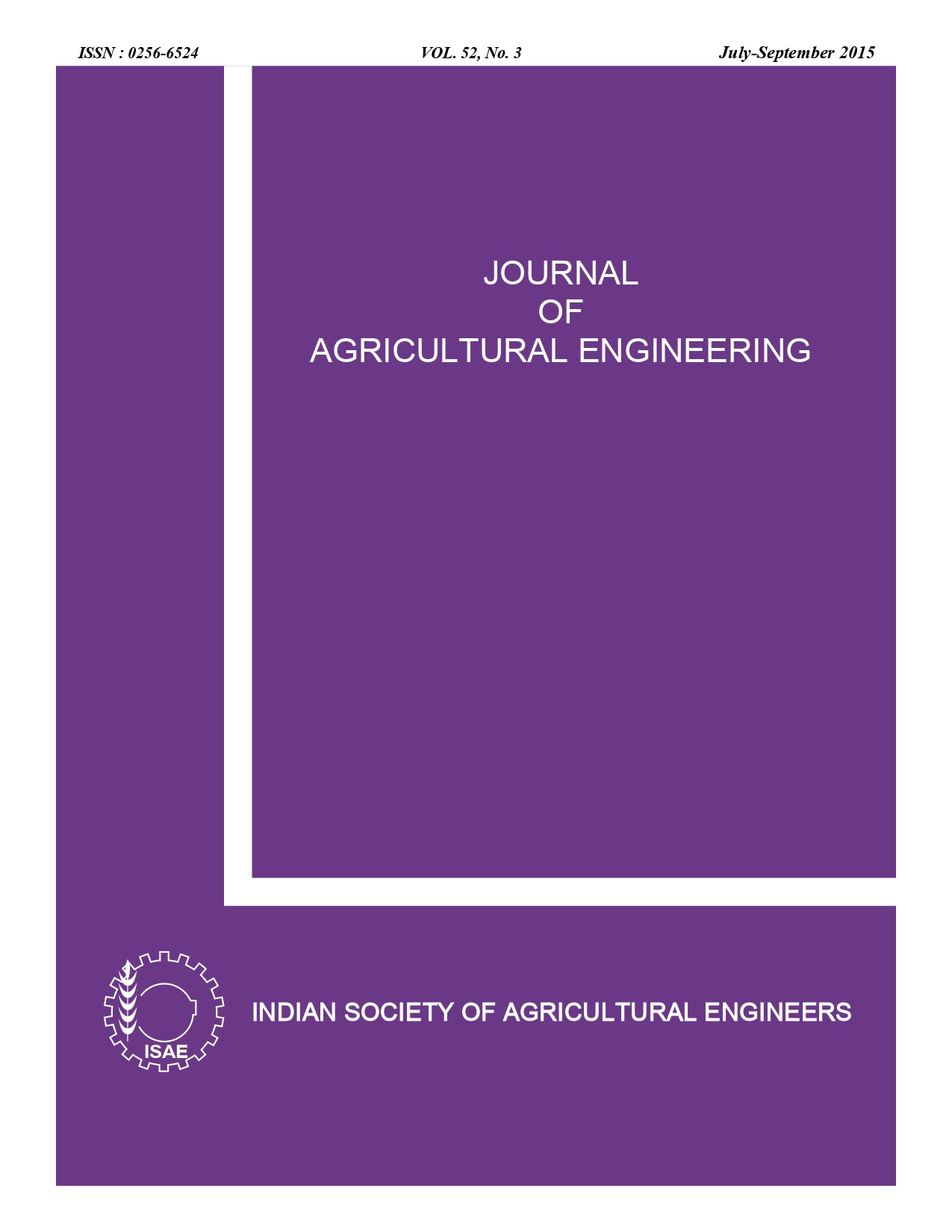Convective Drying of Ginger Rhizomes and Slices
DOI:
https://doi.org/10.52151/jae2015523.1578Keywords:
Ginger rhizome, convective drying, oleoresin content, flavour strength, color valueAbstract
Experimental trials on convective drying of ginger rhizomes and slices (5 and 10 mm) were conducted using factorial completely randomized design. Ginger rhizomes and slices were dried at air temperatures of 50, 60 and 70°C with drying air velocity of 2 m.s-1 in laboratory tray dryer. Drying air temperature was optimized on the basis of maximum retention of oleoresin content, flavour strength and L* value of colour with minimum drying time and specific energy consumption. Optimum temperature for convective drying of ginger rhizomes and slices was found to be 60°C.
References
Abubackar A T N. 2011. Ginger: A rhizome with high export value. Facts ForYou, 23-24.
Aghbashlo M; Kianmehr M H; Akhijahani H S. 2008. Influence of drying conditions on the effective moisture diffusivity, energy of activation and energy consumption during the thin-layer drying of berberis fruit. Energy Conver. Manage., 49(10), 2865–71.
Balladin D A; Headley O; Chang-Yen I; McGaw D. 1997. Extraction and evaluation of the main pungent principles of solar dried West Indian ginger (Zingiberofficinale Roscoe) rhizome. Renewable Energy, 12(2), 125-30.
Deshmukh W; Varma M N; Chang K Y; Wasewar K L. 2014.Investigation of solar drying of ginger (zingiberofficinale): emprical modelling, drying characteristics, and quality study. Chinese J. Eng., Article ID 305823, http://dx.doi.org/10.1155/2014/305823.
Ding S H; An K J; Zhao C P; Li Y; Guo Y H; Wang Z F. 2012. Effect of dryingmethods on volatiles of Chinese ginger (Zingiberofficinale Roscoe). Food Bioprod. Process., 90 (3), 515-524.
Doymaz I. 2004. Drying of leek slices using heated air. J. Food Process Engg, 31(5), 721-37.
Elsamila Aritesty; Dyah Wulandani. 2014. Performance of the rack type-greenhouse effect solar dryer for wild ginger (curcuma xanthorizzaroxb.) drying. Energy Procedia, 47, 94-100.
Hoque M A; Bala B K; Hossain M A; Uddin B M. 2013. Drying kinetics of ginger rhizome (Zingiberofficinale). Bangladesh J. Agric. Res., 38(2), 301-19.
Jayaraman K S; Das Gupta D K. 1992. Dehydration of fruit and vegetables-recent developments in principles and techniques. Drying Technol., 10, 1-50.
Jayashree E; Visvanthan R. 2013. Studies on thin layer drying characteristics of ginger (Zingiberofficinale) in a mechanical tray drier. J. Plantation Crops, 41(1), 86-90.
Jayashree E; Visvanthan R; John Zachariah T. 2012. Quality of dry ginger (Zingiberofficinale) by different drying methods. J. Food Sci. Technol., 51, 823.
Krokida M K; Marinos-Kouris D. 2003. Rehydration kinetics of dehydrated products. J. Food Eng.,57, 1-7.
Loha C; Das R; Choudhury B; Chatterjee P K. 2012. Evaluation of air drying characteristics of sliced ginger (Zingiberofficinale) in a forced convective cabinet dryer and thermal conductivity measurement. J. Food Process Technol., 3,160. doi: 10.4172/2157-7110.1000160.
Maskan A; Kaya S; Maskan M. 2002. Hot air and sun drying of grape leather (pestil). J. Food Eng.,54(1), 81–88.
McMinn W A M; Magee T R A. 1999. Principles, methods and applications of the convective drying of foodstuffs. Trans. Inst. Chem. Eng., 77(c), 175-93.
Mwithiga G; Olwal J O. 2005. The drying kinetics of kale Brassica oleracea in a convective hot air dryer. J. Food Eng.,71, 373–78.
NEPC. 1999. Product profile of ginger. Nigerian Export Promotion Council, B/K 312, Kumba St, Wuse, Zone, II, Abuja, pp: 1-6.
Olajire A A; Azeez L. 2011. Total antioxidant activity, phenolic, flavonoid and ascorbic acid contents of Nigerian vegetables. African J. Food Sci. Technol., 2(2), 22-29.
Pati J R; Santosh K; Hotta S K; Mahanta P. 2015. Effect of waste heat recovery on drying characteristics of sliced ginger in a natural convection dryer. Proc. Eng., 105, 145-152.
Phoungchandang S; Nongsang S; Sanchai P. 2009. The development of ginger drying using tray drying heat pump dehumidified drying and mixed mode solar drying. Drying Technol., 27 (10), 1123–31.
Pokharkar S M; Prasad S. 1998. Mass transfer during osmotic dehydration of Banana slices. J. Food Sci. Technol., 35(4), 336-38.
Prasad J; Prasad A; Vijay V K. 2006. Studies on the drying characteristics of zingiberofficinale under open sun and solar biomass (hybrid) drying. Int. J. Green Energy, 9(1), 79–89.
Premavalli K S; Wadikar D D; Bawa A S. 2005. A ginger munch and a process for the preparation thereof. Appl. No.909/DEL/2005.
Pruthi J S. 2006. Processing and preservation of ginger. J. Spices Aromatic Crops, 1(1), 1-19.
Rahman M S; Lamb J. 1991. Air drying behaviour of fresh and osmotically dehydrated pineapple. J. Food Process Eng., 14, 163-71.
Ranganna S. 2000 Handbook of Analysis and quality control for fruits and vegetable products. Tata McGraw Hill Publishing Co. Ltd., New Delhi.
Shahidi F. 2001. Solvent extraction of oilseeds, nutmeg and other foods using the soxhlet method. Current Protocols in Food Analytical Chemistry, D1.1.1-D1.1.11.
Singh G; Arora S; Kumar S. 2009. Effect of mechanical drying air conditions on quality of turmeric powder. J. Food Sci. Technol., 47(3), 347-50.
Soysal Y; Oztekin S. 2001. Technical and economic performance of a tray dryer for medicinal and aromatic plants. J. Agric. Eng. Res.,79(1), 73-79.
Venkatachalapathy K. 1998. Combined osmotic and microwave drying of strawberries and blueberries. Unpulished Ph.D. Thesis, Agricultural and Biosystems Engineering, McGill University, pp: 170.
Warrier P K; Nambiar V P K; Ramankutty C. 1996. Indian Medicinal Plants-A Compendium of 500 species. Part V, Orient Longman Publishers, India.














